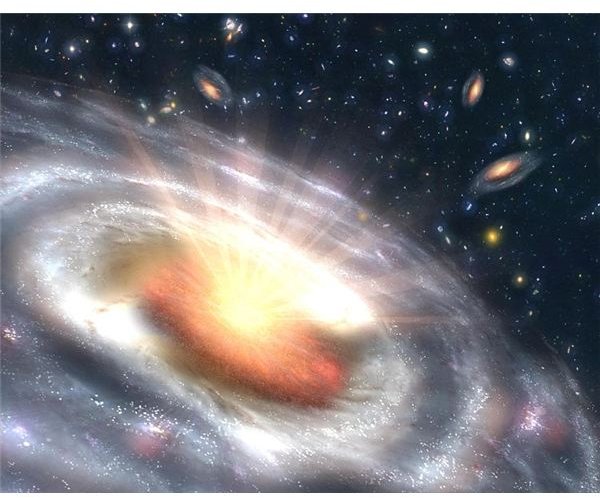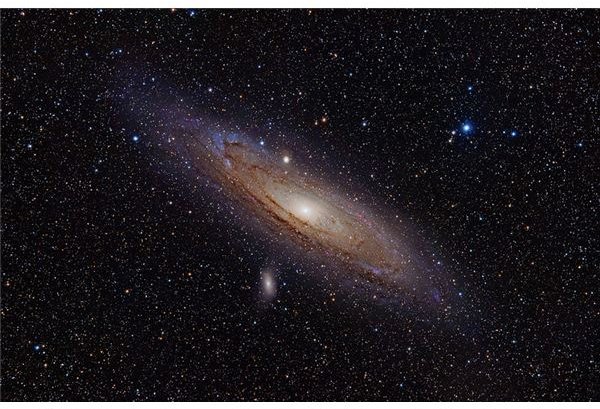An Introduction to Extragalactic Astronomy: The View Beyond Our Milky Way
Galaxies Beyond Our Own
Extragalactic astronomy is the study of everything that lies outside our own galaxy - and there is certainly a lot out there to study! Despite containing an estimated 200-400 billion stars, the Milky Way is just a tiny speck on the cosmic landscape. The observable Universe contains billions of galaxies, organised into groups, clusters and superclusters.
The Milky Way is one of the largest galaxies in our neighbourhood, which is known as the Local Group. The other giant of the group is the Andromeda galaxy, a spiral galaxy containing around one trillion stars. Andromeda shines so brightly that it can be seen with the naked eye despite being over 2.5 million light years from Earth.
Black Holes and Quasars
Most galaxies, including our own, harbor destructive black holes in their centers. A black hole is created when a massive star powerfully explodes in a supernova. The star collapses in on itself, becoming so dense that nothing - not even light - can escape its gravitational pull. Black holes in the middle of galaxies gradually grow larger and larger by consuming dust, stars and planets.
Although black holes themselves are invisible, astronomers can detect them because matter falling into the black hole emits radiation. Matter that is being pulled into the black hole begins to swirl around it in a rotating accretion disk, much like water when it flows down a drain. Frictional forces in the accretion disk generate huge amounts of energy, which is radiated as either visible light, radio or X-rays. Galactic centers that are powered by black holes in this way are known as quasars. They are some of the most luminous objects in the Universe. Astronomers have detected over 200,000 quasars to date.

A Sense of Scale
Reliably calculating distances is one of the most difficult tasks in astronomy beyond our galaxy. The distances to objects within our own galaxy can be calculated using parallax - a technique that measures the amount by which the object shifts compared to background stars as the Earth orbits around the Sun and uses trigonometry to work out the object’s distance. For more distant objects, however, the shift is far too small to be measured. A range of other techniques are used to estimate the distances of extragalactic objects.
Cepheid and RR Lyrae variable stars can be used as distance markers, often referred to as ‘standard candles’, because astronomers can reliably judge the distances of these stars from Earth. The amount of light that is given off by Cepheid or RR Lyrae stars varies periodically, and the relationship between the period of the variation and the star’s intrinsic brightness, or absolute magnitude, is well known to astronomers. By calculating the absolute magnitude of the star and comparing it with the star’s apparent magnitude, astronomers can work out how far away the star is.
Similarly, type 1a supernovae are used as standard candles because a relationship exists between the shape of the supernova’s light curve and its absolute magnitude. Supernovae are visible at much greater distances than Cepheid variables, which makes them extremely useful when studying distant regions.
At the largest scales, astronomers must rely on Hubble’s Law to work out the distance of objects such as quasars or distant galaxies. This relationship, discovered by Edwin Hubble in 1929, states that the redshift of an object, which indicates how fast it is moving away from us, is proportional to its distance. The more distant an object is, the more quickly it is speeding away from us. This effect is due to the expansion of the Universe.
The most distant known objects in the observable Universe are galaxies up to 13 billion light years away. Light that is currently arriving at Earth left these galaxies 13 billion years ago. When astronomers focus their telescopes onto these distant galaxies, they are taking a glimpse into the Universe’s past. In this way, extragalactic astronomy allows us to investigate the Universe’s history.
Cosmology
Cosmology is the study of the origins and evolution of the Universe. The standard model of cosmology is that the Universe began in a hot, dense state known as the Big Bang. A period of rapid inflation expanded and cooled the Universe, resulting in a state in which matter and energy are more or less evenly distributed across the entire Universe. Since the Big Bang, the Universe has been expanding, with the expansion driven by a repulsive force known as dark energy.
Extragalactic astronomy plays a vital role in testing cosmological theories. Studies of extragalactic supernovae, such as the Supernova Legacy Survery, have already provided strong evidence for the existence of dark energy. The Large Synoptic Survey Telescope, which is currently under construction, will study gravitational lensing in distant parts of the Universe to improve our understanding of the action of dark energy.
References
- What is a Quasar? http://www.universetoday.com/73222/what-is-a-quasar/
- Image: Artist’s Impression of Quasar (by NASA) http://photojournal.jpl.nasa.gov/catalog/PIA10093
- Redshift and Hubble’s Law: http://starchild.gsfc.nasa.gov/docs/StarChild/questions/redshift.html
- Image: Andromeda Galaxy (by Adam Evans) http://en.wikipedia.org/wiki/File:Andromeda_Galaxy_(with_h-alpha).jpg
- Supernova Legacy Survey website: http://www.cfht.hawaii.edu/SNLS/
- Use of Cepheid variables as standard candles: https://www.brighthub.com/science/space/articles/33163.aspx
- Large Synoptic Survey Telescope website: http://www.lsst.org/lsst/public/dark_energy
- New Scientist article on Andromeda: http://www.newscientist.com/article/dn9282-andromeda-galaxy-hosts-a-trillion-stars.html
